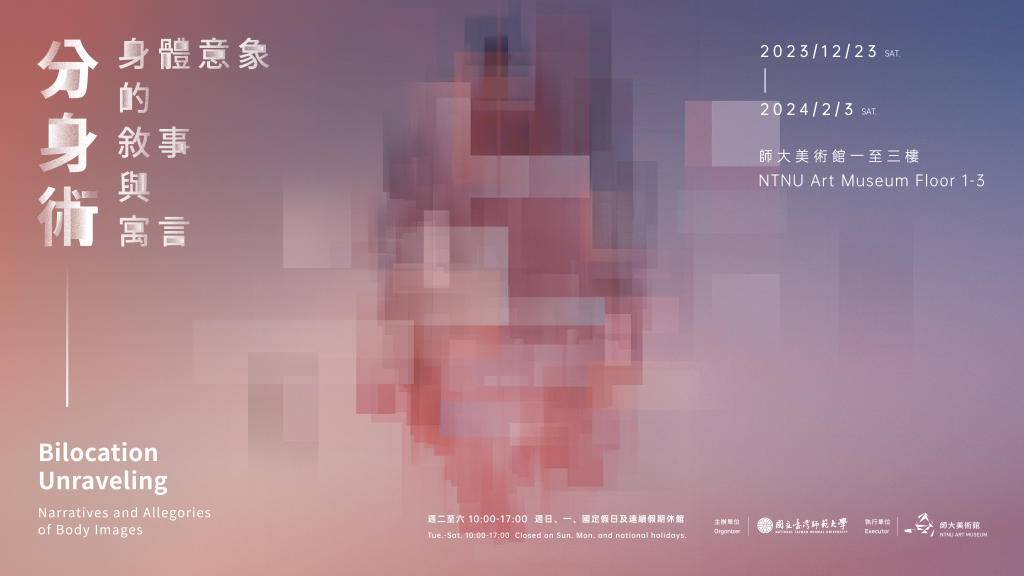
Bilocation Unraveling:
Narratives and Allegories of Body Images
2023/12/23 SAT-2024/2/3 SAT
NTNU Art Museum Floor1-3
Portraits, figures, human figures, and bodies have long constituted a high percentage in arts and convey the social reflection and personal expression of artists. Our exhibition begins with the perspective of “bodyscape,” treating the body and images it facilitates in a work as a landscape conveying symbolic vocabulary; and questions the relationship between the body and personal reality. This topic is initiated by using the concept of “bilocation” to examine the origin of body image and the artists’ observation and imagination of the world.
In “bilocation” or multi-location, images similar to reality or emotional memories connected with reality are used to form a “plural” system that displays multiple body images. The 50 works in our exhibition respond to the topic related to the concept of bilocation in conveying the simultaneous appearance of the same images, the looming appearance of a character with shallow consciousness, a theater that portrays society, or a specific conscious annotation of personal life. Thus, numerous interpretations of body image are presented through the “bilocation.” According to German art historian Hans Belting, images come to life through symbolic meanings and survive through people’s perceptions and memories, as if these images are living in a virtual body of paintings. Through the narratives of body image, artists give their bilocated characters visible bodies to facilitate viewers’ perceptions and memories, making numerous figures in each painting visible in front of the audience. The works in our exhibition feature a variety of media such as oil paint, watercolor, ink, and printmaking from the 1950s to the 1990s to convey the diverse discussion of artists on body image in the postwar era, the “annotations of daily life” in body image, and the “allegorical images” that portray the present reality and the future.
Artists
Chiang, Hsien-Erh; Ho, Yao-Tsung; Wu, Yu-Tang; Lu, Chen-Kuang; Li, Wen-Chien;
Li, Kun-Pei; Tu, Jo-Chou; Shen, I-Cheng; Lin, Chang-Te; Lin, Chung-Han;
Chiu, Chiung-Nuan; Hung, Tien-Kuei; Hung, Ken-Shen; Hung, Ching-Yun; Hou, Li-Jen;
Kao, Shan-Lan; Yuan, Chin-Ta; Sun, Chia-Chin; Chang, Kuang-Chao; Chang, Shu-Mei;
Liang, Hsiu-Chung; Hsu, Tzu-Kuei; Chen, Chieh-Yi; Chen, Shih-Chiang; Chen, Chun-Nan;
Chen, Hsiang-Yin; Chen, Che; Chen, Ching-Jung; Chen, Kuang-Yi; Chen, Huai-En;
Peng, Wan-Chih; Tseng, Shih-Yu; Tang, Yun-Tien; Feng, Cheng-Chih; Huang, Chin-Lung;
Huang, Ming-Chu; Yang, Hsing-Sheng; Liao, Hsiu-Ping; Chao, Hui-Ling; Liu, Chun-Lan;
Teng, Hsien-Chih; Cheng, Chih-Kuei; Lu, Ming-Te; Hsieh, Li-Fa; Han, Hsiang-Ning;
Lo, Fang; Tan, Hsing-Chien; Su, Shih-Hsiung; Su, Hsien-Fa; u, Ping-Hsing;
Organizer: National Taiwan Normal University
Executor: NTNU Art Museum Provisional Office